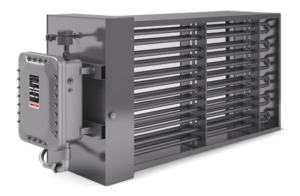Why Explosion-Proof Duct Heaters Matter in Mining
Last updated on November 2nd, 2022 at 03:29 pm
Mining is an inherently high-risk industry. In addition to the extraction of certain elements, the mines’ environments can put workers at risk of injury or illness. Explosive gases and compounds are among these risks. However, explosion-proof heaters can reduce the odds of combustible gasses igniting.
Explosion-proof duct heaters improve safety, comfort, efficiency
 Explosion-proof heaters have become standard in many operations because they offer numerous benefits. First, they provide a high level of comfort heating, especially at mining sites in colder climates. Second, they’re also adept at maximizing efficiency. For example, copper mining operations often rely on explosion-proof heaters to dry out wet copper concentrate to prevent energy wasting and poor gas flow.
Explosion-proof heaters have become standard in many operations because they offer numerous benefits. First, they provide a high level of comfort heating, especially at mining sites in colder climates. Second, they’re also adept at maximizing efficiency. For example, copper mining operations often rely on explosion-proof heaters to dry out wet copper concentrate to prevent energy wasting and poor gas flow.
However, the key benefit of explosion-proof duct heaters is safety. Mining requires adequate ventilation and circulation of air because there’s a volatile combination of hot air and combustible gases in mines.
Substances of concern
It should be no surprise that many dangerous gases circulate in mine shafts. The most obvious danger with these substances is their flammability. In some instances, all it takes is an open flame in the presence of these gases to ignite a blaze. Of course, the consequences of such an event would be disastrous.
Here’s a more detailed look at these substances.
Carbon monoxide — CO (Whitedamp and Afterdamp)
Also known as the “silent killer” of gases, carbon monoxide can lead to death if levels reach just 0.2%. Miners famously sent canaries down shafts in the nineteenth and twentieth centuries to help them detect this deadly gas. Even at low CO levels, canaries suffered breathing difficulty and agitation, followed by erratic flight or collapse. This low level of gas could poison and kill workers.
Wearing a respirator protects workers from inhaling the gas. However, masks don’t protect workers against combustion. Carbon monoxide poses a high risk of explosion when it mixes with air between 12.5 to 74% concentrations. The most explosive level is 29%.
Carbon dioxide — CO2 (Black damp)
Carbon dioxide isn’t toxic itself. It only becomes dangerous when mixed with air since it reduces the available oxygen one can breathe. That said, a concentration of 3% can cause breathing difficulty, while 18% can kill. Carbon dioxide isn’t explosive but must be circulated out of a mining shaft.
Hydrogen sulfide — H2S (Stinkdamp)
Similar to carbon monoxide, hydrogen sulphide is a perfect storm in terms of risk. It’s highly toxic, flammable, and colourless. However, the difference with this gas is that it has a pungent smell.
Trace levels can kill humans via asphyxiation, while more minute levels can cause breathing difficulty, motor issues, and headaches. But the flammable nature of hydrogen sulphide makes it a concern for miners. A mixture of 4.5 to 45% with air can ignite in the presence of a flame.
Hydrogen cyanide — HCN
Like other gases on this list, hydrogen cyanide is colourless, highly toxic, and, above all, flammable. Distinguished by its bitter almond odour, hydrogen cyanide mixes very well with air and can ignite easily under the right circumstances. Usually, combustion happens at a concentration of 5.6% to 40%.
It’s important to note that hydrogen cyanide can have severe and deadly effects on those who inhale or absorb it cutaneously. They include gastrointestinal illness, nervous system dysfunction, and even coma.
Methane — CH4 (Firedamp)
Methane is indigenous to mines and, of course, a key component of natural gas. With that said, this colourless, odourless gas is noxious and highly flammable. Regarding combustion, methane will only ignite at concentrations between 4 to16%. However, all it takes is a spark or naked flame to cause an explosion with methane at these levels.
Explosion-proof duct heaters mitigate ignition risks
The danger with many heaters is that the heat they produce can ignite the gases mentioned above. It’s impossible to guarantee the absence of gases in a mine or that they’re present at safe levels. The danger often lurks unknowingly. But explosion-proof duct heaters can circulate hot air needed for various industrial applications without overheating flammable gases. They can do this through a few safety features.
Safety features of explosion-proof duct heaters
- Carbon steel, nickel-plated fins that allow for low-temperature heat transfer;
- Thermocouples (heat-sensing equipment) that shut down a duct heater if it surpasses a temperature threshold;
- Differential pressure switches that can turn on fans, open or close dampers or turn on warning lights and alarms.
These mechanisms are unique to explosion-proof duct heaters, unlike others. Here at Wattco, we recommend using explosion-proof duct heaters for mining operations where flammable gases may linger.
Explosion-proof products/solutions
Finding the right explosion-proof duct heater largely depends on the mining application. Different processes require different conditions. You can use a six-step method to find a suitable unit, though.
- Find the temperature code rating
- Determine the wattage
- Find out the air flow requirements
- Determine duct size
- Find the voltage
- Calculate temperature rise
By determining these factors from the outset, you’ll have an easier time figuring out which explosion-proof duct heater will work best. Every mining application will have ideal requirements for each of these factors. Choosing a heater that meets those requirements will help keep you and your crew safe from combustible gases.
Get in touch with us to help you find the right heaters for your mining operations.
